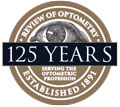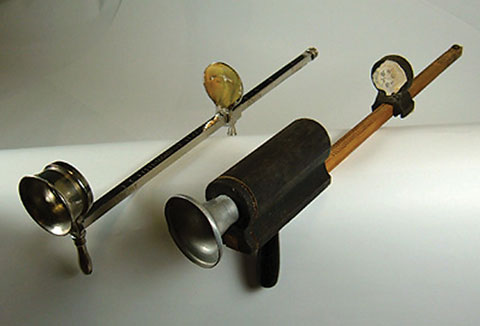 |
How often do you stop to think about a name—what it means or how it was chosen? I, for one, have been doing so a lot. After months of deliberations and many discarded lists, I finally settled on a name for my first child. So it’s fitting to be discussing how, and by whom, optometry got its name.
As it turns out, naming an entire profession can be just as difficult as naming a child, and the choice can be just as crucial in shaping the future. How might the profession differ if you were called visometricians or qual-optists? These were both on the short list when the British Optical Association sought suggestions for a title in 1903.1 Perhaps luckily, American eye care providers were already well on their way to being known as optometrists by this time.
From Opticianry to Optometry
The history of the word optometry is somewhat debated and, like all good origin stories, it is rife with key players laying claim to the title of founding father.
Many agree the word itself came about as early as 1731, when Scottish physician William Porterfield created what he called an optometer to carry out Christopher Scheiner’s experiment for measuring refraction.2 More than 150 years later, both optometer and optometry appear in Swiss ophthalmologist Edmund Landolt’s 1886 textbook The Refraction and Accommodation of the Eye and Their Anomalies.2
Around that time—the late 1800s—refracting opticians got down to the business of separating themselves from dispensing opticians and felt the desire to rename their nascent profession. Review of Optometry, itself no stranger to name changes, debuted in 1891 as The Optician. Always an advocate for change, the publication played a key role in the early effort to enact the profession’s name change. In 1895, the first issue of the newly renamed Optical Journal included an article by R.H. Knowles, MD, which declares, “The instrument used for determining eye defects is called an optometer,” and “the science of using this instrument is called optometry.”2
Just a few years later in 1899, Frederick Boger, The Optical Journal’s founder and editor, became the first to lobby for the adoption of the title optometry. “While the term optician fully covers all branches in which opticians are now engaged, the new profession will have to adopt some other title distinctive of what it has to deal with,” Mr. Boger wrote. “The word optometry has come much into vogue recently and seems to be popular and to fit the case.”3
 |
| Silver and wood optometers from the 1920s. Image: The Archives and Museum of Optometry. |
Four years later, the term was officially adopted by the American Optometric Association (then called the American Association of Opticians). As recorded by a 1938 article in The Optical Journal, Dr. Emanuel Klein—not Dr. Knowles—coined the term optometrist some time before 1902 as an alternative to opticist, which had been advocated by Dr. Charles Prentice.4 Dr. Klein then suggested to his friend, Dr. John C. Eberhardt, that he introduce a proposal to adopt optometry and optometrist at the 1903 AOA convention in Atlantic City. The proposal was deferred to the next year’s convention, during which Dr. Eberhardt, now the president of the AOA, reintroduced it for adoption. “A long discussion followed but closed with the unanimous adoption of the two words,” along with their related definitions.4
In a 1941 retrospective, Dr. John Jarvis, then director of the AOA department of public relations, reflected on the vote. “It is my understanding that Eberhardt had been trained as an engineer. He was therefore of that type of mind enamored of accuracy, so he sought a Greek root. The term ‘Optician’ did not, in his opinion, express clearly enough the work to be done by the fast moving group who wanted a profession.”5
The name had its share of detractors, including Dr. Prentice, who steadfastly continued to call himself an opticist. Dr. Jarvis relates an anecdote about Dr. Prentice expressing dislike of the term. During an AOA convention in Rochester, NY, attendees were required to list their profession. “I am more than an optician, but I do not like the term optometrist,” Dr. Prentice said to Dr. Jarvis. “I think this is more accurate, and understandable,” as he wrote opticist next to his name. Dr. Jarvis recalls that others nearby “made general comment to the effect that, as we would say in the present day vernacular, ‘he had something.’” Maybe so, but optometry stuck, despite its shortcomings.5
A Greek reader of this magazine pointed out in a 1938 letter to the editor that opto in classical Greek means “I see” and thus optometrist, strictly speaking, means “I see measurements.”6 Better terms, he said, would be opticometry and opticometrist, though these too he found unsatisfactory. “The word metry represents rather the carpenter who makes measurements than the optometrist who is a professional person correcting the optical defects of the eye” through knowledge of a science. Opticology and opticologist—or optico, for short—the letter-writer felt, did the best job of conveying the profession’s scope and skill.
Of course, The Optical Journal and Review of Optometry—the name this publication adopted in 1910—continued to play a pivotal role in popularizing the new moniker. A 1941 article admits that, while credit for naming the profession belongs to others, the magazine deserves a place among the founders as well: “the real credit for the final adoption of the title ‘Op-to’-metrist,’ as it was then pronounced, later to become ‘Op-tom’-etrist,’ must be largely given to Boger.”7 Mr. Boger had once again promoted the term optometry in June of 1904, stating that the name had already been settled before its adoption by the AOA. His proof? Minnesota, California and North Dakota were the first three states to enact laws governing the practice, and they used the term optometrist.7
By Any Other Name
While optometry was first defined as “the science of non-medical refraction,” back in 1904, the name now encompasses a much more robust profession that continues to push for expanded scope of practice.8
Still, some practitioners chafe at the perceived limitations of a word rooted in measurement. Back in 1940, there was a flash-in-the-pan movement afoot in the Midwest to change the profession’s name from optometry to ommatology that clearly went nowhere.9 And many optometrists in recent years have adopted the use of optometric physician to better reflect their involvement in the broader health care landscape.
Who knows, maybe the profession will eventually outgrow its title and be ready for another name change. The British optometrists of 1903 have some more good options to choose from—Opticmatrician? Or maybe Licentiate in Optics?
One thing is for sure: no matter what optometrists start calling themselves in the future, Review of Optometry will be there to spread the word.
|
1. Optometric Historical Society Newsletter. 1970. 2. Cox ME. Optometry, the Profession. Its Antecedents, Birth, and Development. Being a Series of Editorial Articles Appearing Under the Title “The Basis of Optometry’s Public Relations” in Optical Journal and Review of Optometry from October 1, 1945 to January 1947. 1957. 3. Penisten D. Optometry’s 100-Year Wars. Review of Optometry. January 1991. 4. “The Word ‘Optometry.’” Optical Journal and Review of Optometry. July 11, 1938. 5. Jarvis JW. The formative days of optometry. Optical Journal-Review. January 15, 1941:28-29. 6. Haidopoulo GD. That word “optometry.” Optical Journal-Review. June 15, 1938:46. 7. Hammon JH. Changing Methods of Practice. Optical Journal and Review of Optometry. January 15, 1941. 8. Brought to a Focus. Optical Journal and Review of Optometry. January 15, 1934.9. “Ommatology” as the new “optometry.” Optical Journal and Review of Optometry. July 1, 1940:32. |

